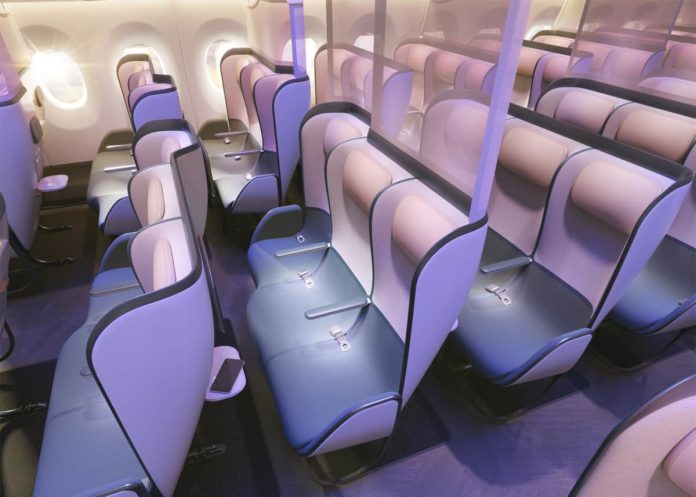Redesigning the economy class has moved up the priority list as a result of the pandemic. Concepts have been popping up all over the world from various designers trying to rethink how we travel. This includes London based design consultancy PriestmanGoode, and when one of the world’s most out-of-the-box design houses gets going with a concept, you know it’s going to be incredible. Here’s what you need to know about Pure Skies Zones.

The future of economy class
If there’s one thing we’ve learned from the impact of the pandemic, it’s that people are becoming less and less willing to be squeezed like sardines into economy class seats. Although passenger density has undoubtedly led to the proliferation of low ticket prices, in the post-pandemic world where hygiene is at the front of our minds, passengers are likely to want a little more space.
Stay informed: Sign up for our daily aviation news digest.
We’ve already seen some interesting concepts that propose different ways to do this. From seats where people face in different directions to retrofit concepts that assist in blocking the middle seat, it seems designers everywhere are beavering away to develop the aircraft cabin of the future.
But one design team has taken the economy class concept to a whole other level. Earlier today, we revealed the business class concept PriestmanGoode calls the ‘Pure Skies Rooms.’ Now, let’s take a look at the sister product, an economy solution the London design house calls ‘Pure Skies Zones’.

Pure Skies Zones
The concept of Pure Skies Zones works on the same principles as the business class proposition: personal space, hygiene, and a touch-free journey. The concept makes use of inbuilt design features to boost passenger confidence, and to make it easier for airlines to provide the safe and clean environment that their customers want.
In the economy cabin, PriestmanGoode has created zones to separate passengers from the masses and help them feel more protected. Seat to ceiling dividers every other row and a staggered seating arrangement let passengers sit together with their family or separate and alone, as needs define.

The seats themselves are contained within a hard shell, removing gaps that can become traps for dirt and germs. The seat fabric is designed using materials and methods that raise the bar for sanitation.

The antimicrobial cloth is seam welded, again to remove the openings where viruses and other contaminants can accumulate. Even the recline mechanism is entirely contained within the fabric skin, so there are no hard to clean openings.

In a trend we’ve seen widely adopted on many airlines, PriestmanGoode suggest the complete removal of IFE screens in favor of a ‘bring your own device’ policy. This allows for straighter, slimmer seats with greater pitch, and fewer shared touch areas to spread contaminants.

Also gone from the design are seatback literature pockets. Airlines can instead present a clean, removable bag to passengers on embarkation, or passengers can bring their own bag to clip into the area. The seatback tray is also no more. Instead, a clip-on meal tray will come directly from the trolley.

Benefits for airlines
Pure Skies Zones is interesting from a passenger point of view, as there are many features designed to put fliers at ease when traveling in economy. However, the company has also kept airlines in mind, too, suggesting various revenue opportunities available and the ability to tailor products for passengers around their individual preferences.
Jo Rowan, Associate Director of Strategy at PriestmanGoode said,
“We have designed a clearly defined product offering which provides benefits on many levels. We’ve also enabled a more enhanced offering where the upgrades are clearly apparent as part of an unbundled structure that consumers are increasingly aware of – the ‘get what you pay for mindset.’ It’s a highly democratic product and service proposition.”
What do you think of the economy concept from this London design house? Let us know in the comments.
[ad_2]
Source link

